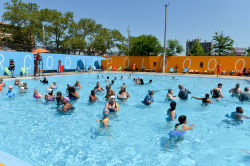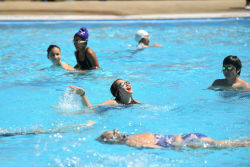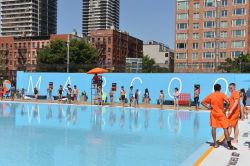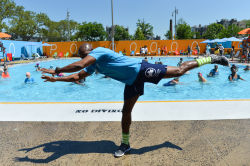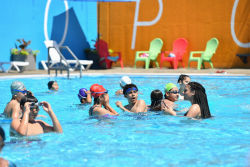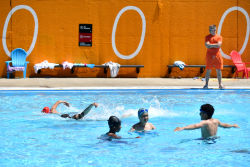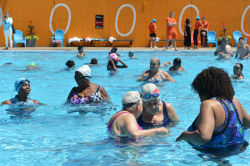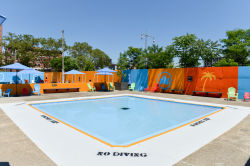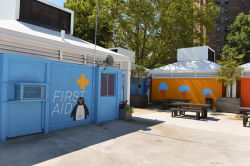Wagner Houses Pool
Mayor Wagner Pool
For outdoor pool details, including hours and rules, please visit our Free Outdoor Pools page.
This pool and recreation area, located on East 124th Street between First and Second Avenues, is named for Mayor Robert F. Wagner (1910-1991), one of only three mayors of post-consolidation New York City to hold office for three terms (Fiorello H. LaGuardia [1882-1947] and Edward I. Koch [1924- ] were the other two). Wagner’s administrations were marked by a great deal of construction, much of it under the direction of Robert Moses (1888-1981, Parks Commissioner 1934-60). The Harlem River Drive, Shea Stadium, Lincoln Center, the Verrazano-Narrows Bridge, and many public housing projects were all built while Wagner was mayor. He is also remembered for hiring minorities for prominent city positions (a rarity at the time), passing legislation aimed at ending housing discrimination, and forging a consensus among lawmakers and union leaders.
Wagner was born in New York City, and graduated from Yale College, Yale Law School, and Harvard Business School. He was elected to the New York State Assembly in 1937 but resigned in 1941 to join the Army Air Corps. After serving in North Africa during World War II, he was appointed tax commissioner and later commissioner of housing and buildings under Mayor William O’Dwyer (1890-1964). In 1949, Wagner was elected Manhattan Borough President with the support of the Democratic and Liberal parties. With the support of the Democratic county machine, Wagner was elected mayor in 1953, and was reelected in 1957. After breaking with Tammany, Wagner again won reelection in 1961 as a reformer.
The Wagner Houses, the huge residential complex sitting to the northeast, are named for Mayor Wagner’s father, U.S. Senator Robert F. Wagner (1877-1953). Born in Nastatten, Germany, Wagner immigrated with his family to the United States in 1886. He graduated from City College of New York in 1898 and from New York Law School two years later. After law school, Wagner joined the Tammany Society and became a staunch Democrat. In 1904, he was elected to the State Assembly, and was a major supporter of the reform policies of Governor Alfred E. Smith (1873-1944).
Wagner was elected to the U.S. Senate in 1926, and during his service co-sponsored the Wagner-Peyser Act, which created the United States Employment Service that later became part of the Social Security board. His other notable legislation included the Wagner-Connery Act, which established the National Labor Relations Board (NLRB), and the Wagner-Steagall Act, which set up the United States Housing Authority (USHA), forerunner to the Department of Housing and Urban Development (HUD). Wagner continued to fight for social causes in the Senate until 1949, when poor health forced him to retire. He died four years later at the age of 75. Because of his important role in creating public housing, this complex, built in the early 1950s and originally known as the Triborough Houses because of the nearby bridge, was renamed to honor Senator Wagner.
Mayor Wagner’s son, Robert F. Wagner, Jr. (1944-1993), continued the family tradition with a career in government. A graduate of Exeter, Harvard College, and the Woodrow Wilson school at Princeton, he was elected a New York City Council Member representing Manhattan (1974-77). Mayor Koch appointed him Chairman of the City Planning Commission (1978-79), Deputy Mayor for Policy (1979-86), and President of the New York City Board of Education (1986-90).
The New York City Housing Authority leased this property to the city in 1969 to develop a public pool for the community. The 3’6” deep square pool, changing rooms, and public restrooms were all built using modular construction techniques. The buildings, pool siding, and filtering equipment were all prefabricated in a factory, shipped on trucks, and bolted and sealed together at the site. Recently, a garden was planted next to the pool’s entrance, supplementing an already existing apple tree, which bears edible fruit every year (largely for the benefit of local squirrels). In 1999, this property, also known as the Hilda E. Stokely Recreation Center, underwent a $43,891 renovation funded by Mayor Giuliani. The rehabilitation project featured the installation of new steel fences with bear claw extensions, and new concrete and asphalt pavements. Today, Mayor Wagner Pool serves as a memorial to a dedicated political leader and a refreshing place for rest and recreation.
Check out your park's Vital Signs
Clean & Safe
Green & Resilient
Empowered & Engaged Users
Share your feedback or learn more about how this park is part of a
Vital Park System

